Galerie Lelong & Co., New York, is pleased to present Here at Home, an intimate presentation of prints by Nancy Spero, commemorating the artist’s birthday on August 24, 1926. For Spero, print-making offered an entry point for the larger conversation of radical change.
“The repetition inherent in the printing process echoes the irrepressible presence of women in history I seek to capture by combining and recombining images of women from very different historical periods and cultural contexts. Yet my intervention is not neutral history, is not fixed, it’s mutable, open to interpretation, it keeps on living by accumulating new meanings. Now this is a very subversive idea, because it means history can be changed, power relations reversed. . .” - Nancy Spero
In this selection of six works, Spero's prints and her many methods—lithography, silkscreen, and letterpress—are on display along with an evolution that embraced color, humor, and rhythm. In 1975, following a chance remark by the proprietor of a print shop to transfer her painted figures to zinc plates, Spero developed a lexicon of images that permitted her to reproduce, repeat, and recycle images freely and infinitely. In the ensuing years she frequently spoke of “cannibalizing” her work, a methodological byproduct of the printing technique she adopted. Her technique comprised overprinting and juxtaposing these images (numbering over 400 characters in her “stock company”) often heightening the figures’ contours with gouache and collaged silhouettes that allowed her figures space for movement and suspension.
In 1987, Spero described how this new printing process effected the production and outcome of the final image. By using the zinc letter press plates that start from her drawings and appropriations, she states, “I am able to get many variations of imprint. Depending on the pressure of the hand, the angling of the plate, the amount of ink rolled onto the raised image etc., I can repeat and differentiate an image, emphasizing the staccato of the mechanical, varying hand printing directly on the paper itself with collaged hand printed images [….] Gravity and ground plane are referenced or inferred and continuously contravened.” This new application by the pressure of her hand, rather than a printing press, brings these panels closer to the realm of drawing. Like drawing with a pencil using weight applied to the paper, Spero can also use her own physical force to vary the application of the imagery.
From her most introspective pieces to her activism, Spero’s oeuvre was driven by a deeply personal and uncompromising expression of her experience. Just as the artist often verbalized, there is a dialogue in need of provoking, a recognition of anger, and action to be taken. Since her death in 2009, Spero’s works have continued to resound with issues of injustice faced today; her message of empowerment lives on, a reminder that from wherever we are, we can act as individuals and as collectives to refute the “same damn thing.”
To schedule a viewing appointment or for any sales enquiries, please email us at art@galerielelong.com.
Please scroll down to read about individual prints
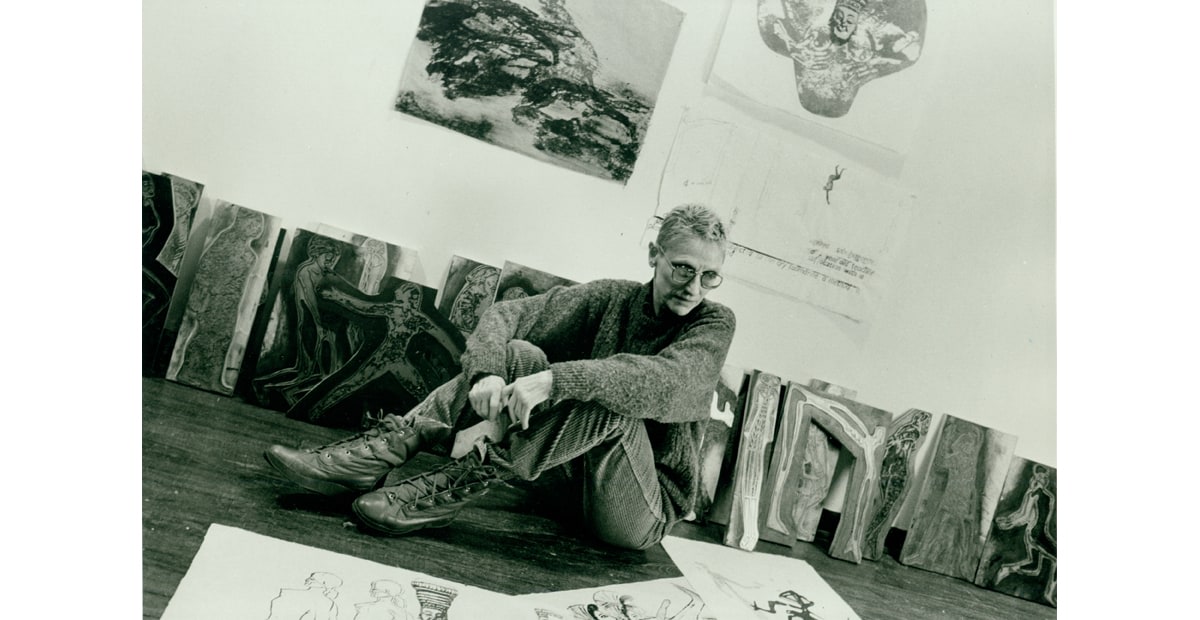
ABOUT THE ARTIST
In a groundbreaking career surpassing 50 years of practice and encompassing many significant visual and cultural movements including Conceptual Art, Post-Modernism, and Feminism, Nancy Spero made the female experience central to her art and challenged aesthetic and political conventions. Spero’s lexicon was derived from an immersion in the history of images, notably from Egypt, classical antiquity, pre-history, and contemporary news media. She combined, fractured, and repurposed found imagery and adopted text to comment on contemporary and historical events such as the monstrosities of the Vietnam War, extermination of Jews during the Holocaust, and torture of women in Chile. With raw intensity, Spero executed works on paper and installations that persist as unapologetic statements against the pervasive abuse of power, Western privilege, and male dominance. Spero’s work is held in over 50 prominent public collections worldwide
including the Art Institute of Chicago, Illinois; Centre Pompidou, France; Museo Nacional Centro de Arte Reina Sofía, Spain; Museum of Modern Art, New York; National Gallery of Art, Washington, D.C.; Tate Gallery, England; Whitney Museum of American Art, New York; Museum of Fine Arts Boston, Massachusetts; and Dallas Museum of Art, Texas. Major monographic exhibitions of Spero’s work have been shown at renowned museums including the Museo Rufino Tamayo, Mexico; Centre Pompidou, France; Serpentine Galleries, England; Museo d’Art Contemporani de Barcelona, Museo Nacional Centro de Arte Reina Sofia, and Centro Andaluz de Arte Contemporáneo, Spain. In 2007, Spero presented the installation Maypole: Take No Prisoners at the 52nd Venice Biennale.
Spero was born in Cleveland, Ohio, in 1926. She died in New York City in 2009.
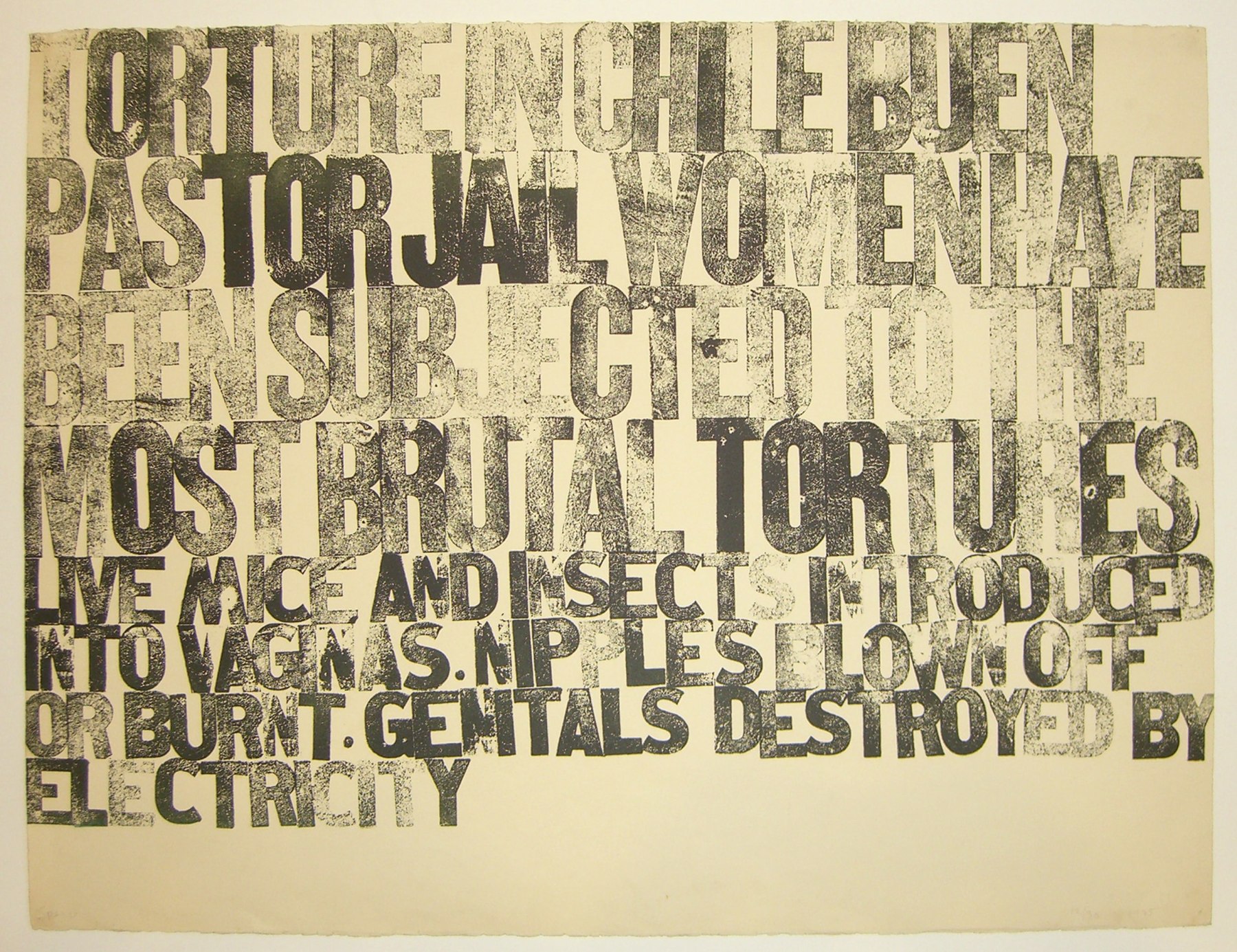
Nancy Spero, Torture in Chile, 1975. Photo lithograph, 22 1/4 x 30 inches (56.5 x 76.2 cm), Edition 12 of 30 (#12/30).
The documentary aspect of Spero’s work is evident in her use of newspaper reports and case histories of torture, with the victims’ names and their country of origin clearly indicated. Starting in 1974, Spero made two series that dealt with torture: Torture in Chile (1974) and Torture of Women (1974-76), both based on case histories taken from the annals of Amnesty International in South America. Torture in Chile directly references the September 1973 coup d’etat which deposed
Chilean president Salvador Allende, an event marked by the extreme violence with which supporters of the former government were suppressed. To the emerging reports of the inhumane treatment meted out to opponents of the new regime, Spero responded with a harrowing, boldly graphic work which quoted directly from an article that revealed the terrible punishments inflicted on Chilean women in Pinochet’s jails.
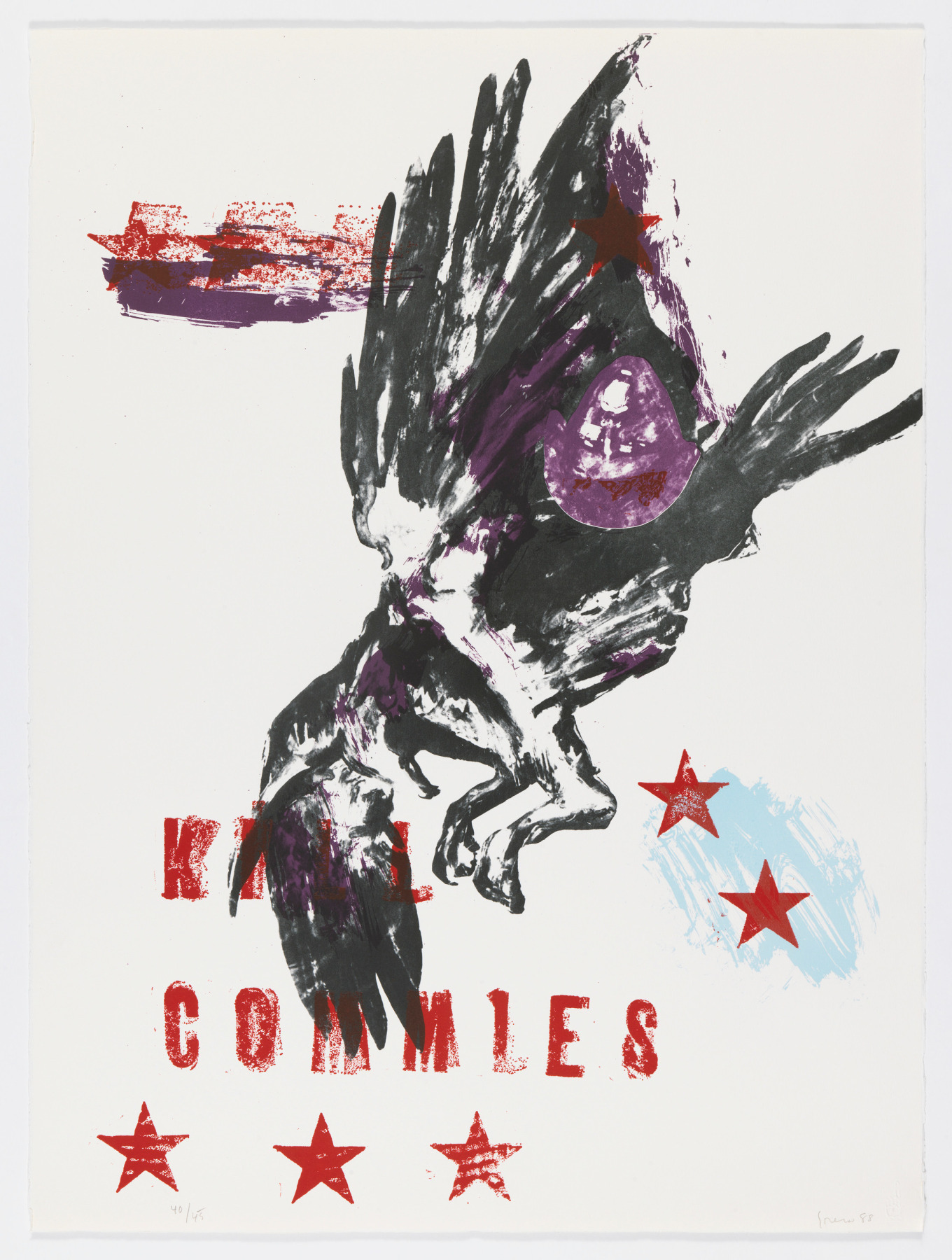
Nancy Spero, Kill Commies, 1988. Lithograph, 32 x 22 inches (81.3 x 55.9 cm). Edition 12 of 45 with 14 APs (#12/45).
"This is what I consider the obscenity of the war. I thought the terminology and slogans like ‘pacification’ coming out of the Pentagon were really an obscene use of language. They would firebomb whole villages and then the peasants would be relocated into refugee camps... The doubled-headed eagle is a man’s head with a tongue and then an eagle’s head." - Nancy Spero, on The War Series, from which the subject matter of Kill Commies was first depicted in Eagle,Victim and Medusa Head (1969), a gouache, ink, collage work on paper.
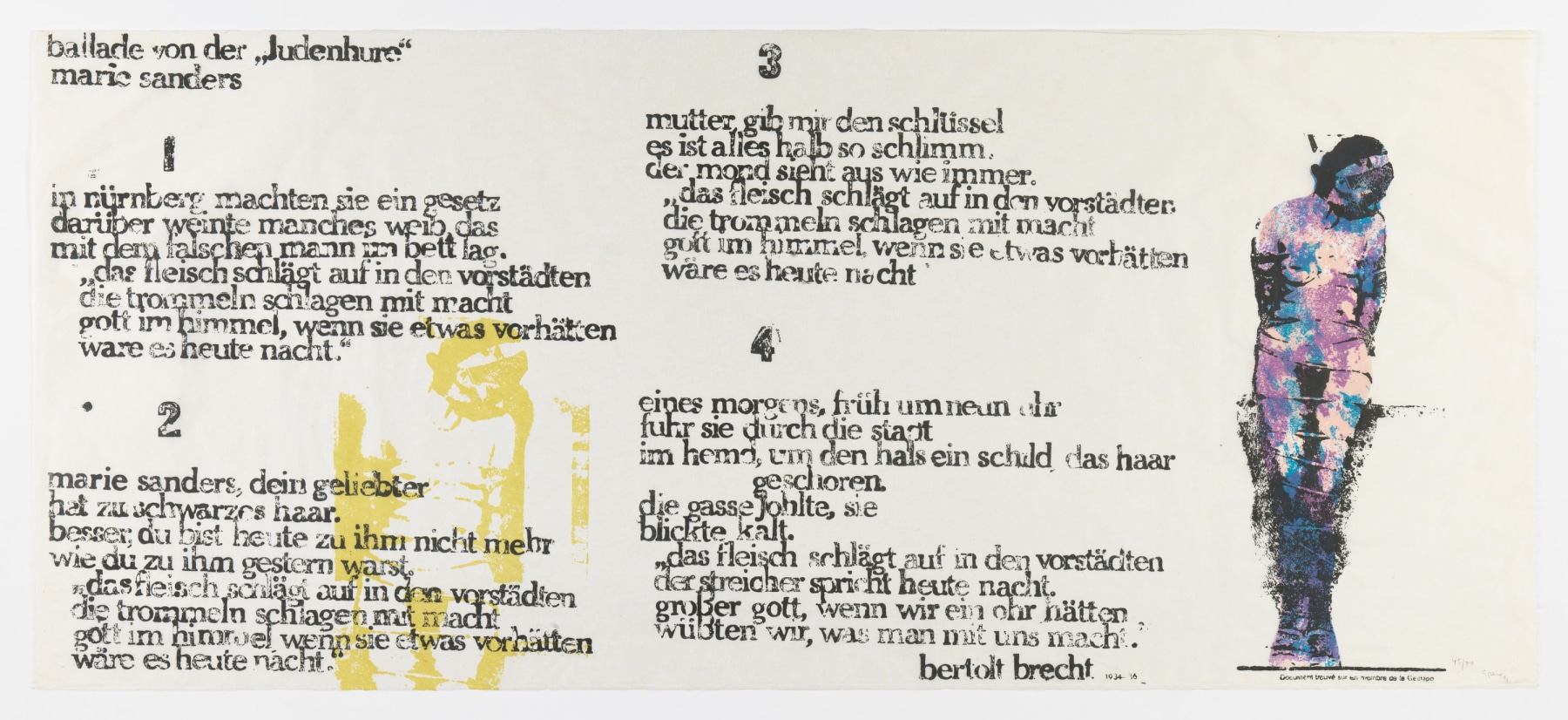
Nancy Spero, Ballade von der Judenhure Marie Sanders (Ballad of Marie Sanders, The Jew's Whore), 1991. Numbered, signed, and dated in graphite on recto. Lithograph, 21 x 48 inches (53.3 x 121.9 cm), Edition 45 of 70 (#45/70).
This lithograph was made after an installation of the same title, Ballad of Marie Sanders, The Jew’s Whore (1990), which Spero did at the Smith College Museum of Art in Northampton, Massachusetts. Here she reintroduced text, and for the first time since Notes in Times (1976-79), an anguished theme, printing directly on the wall verses from a 1934 ballad by Bertolt Brecht about a gentile woman who was tortured for having sexual relations with a Jew. In 1993, Spero did another wall installation for the inauguration of the newly renovated Jewish Museum in New
York City, based on the same piece. This image was used by Spero beginning in the early 1990s when she created three installations that explored female experience and suffering during World War II. The image is based on an archival photograph of a naked woman, bound by rope, gagged, with a noose hung around her neck. Just below her image, a French caption reads, “Document trouvé sur un membre de la Gestapo,” (“Document found on a member of the Gestapo”).
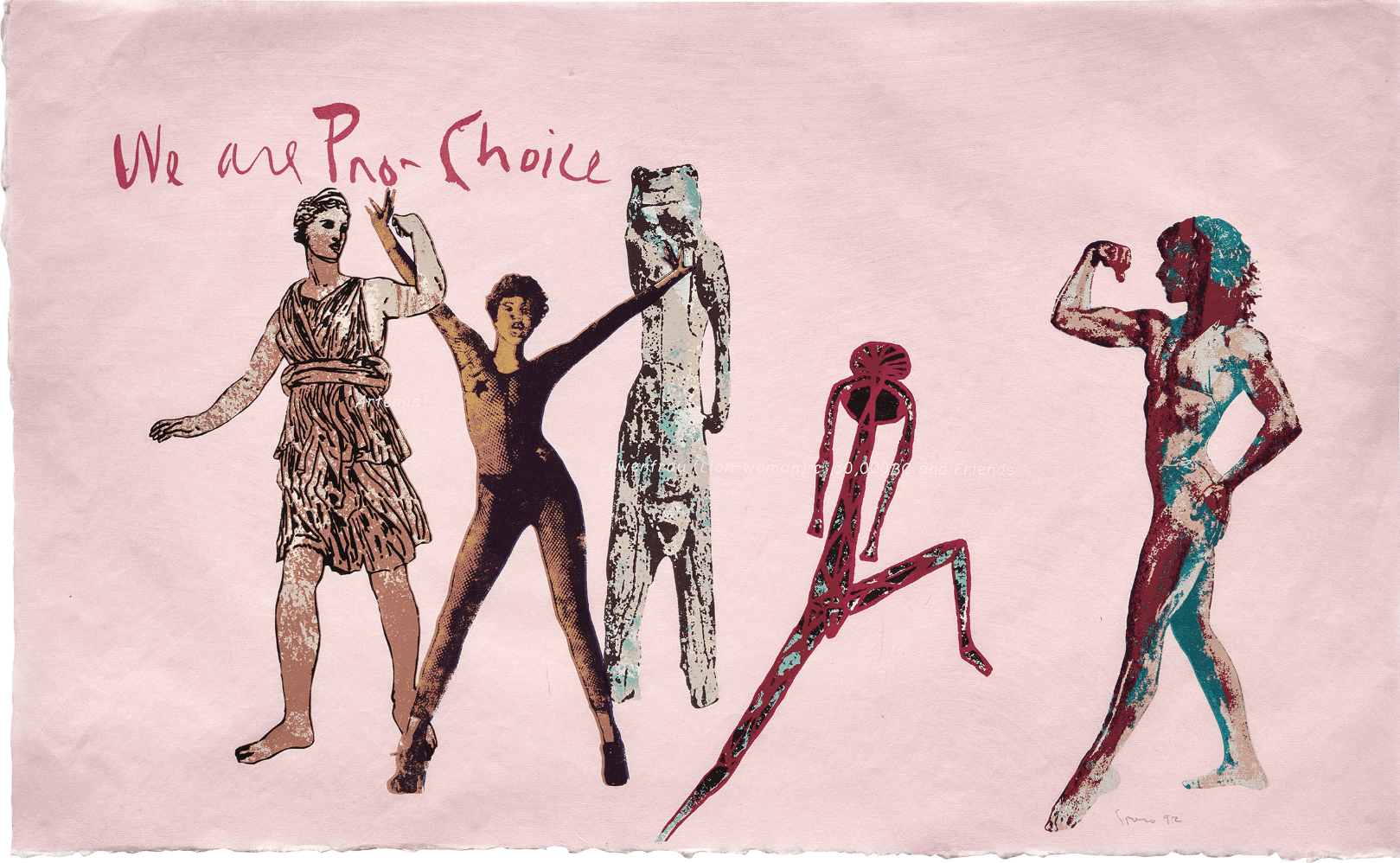
Nancy Spero, We are Pro-Choice, 1992. Silkscreen, 16 1/4 x 26 inches (41.3 x 66 cm), Edition of 75 plus 5 artist's proofs.
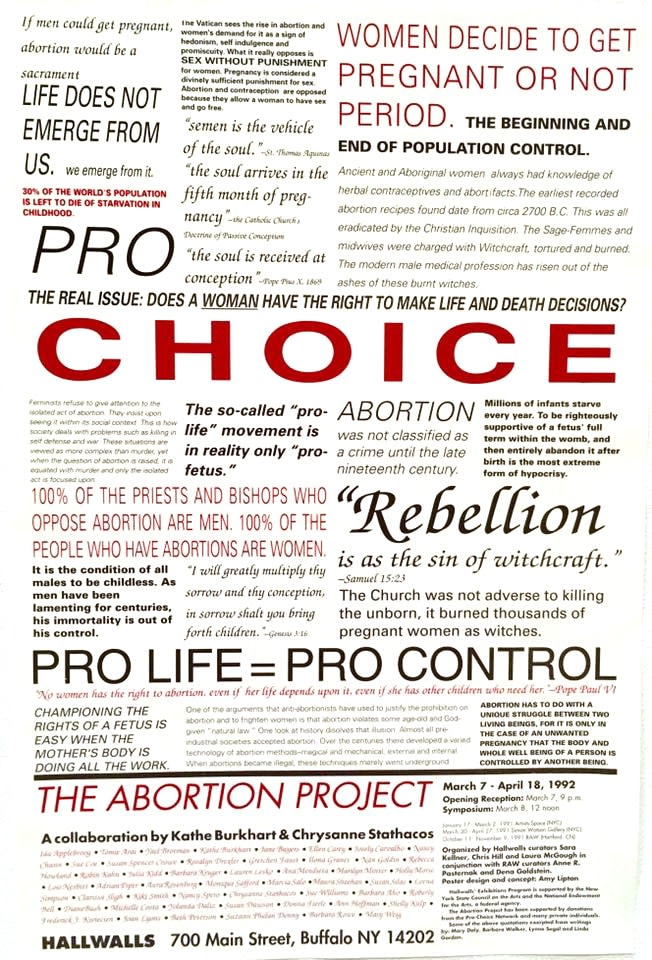
This poster is the Hallwalls version of the poster designed by artist Amy Lipton that was originally commissioned by Anne Pasternak for the show's run at Real Art Ways in Hartford, CT.
Made in 1992, Nancy Spero's We are Pro-Choice features its title in the artist's handwriting on the top left, and a suite of hieroglyphs: Artemis reaching for her arrow, a woman with stars on her chest and in fishnet, the Lowenfrau, a patterened Aboriginal figure with its leg up, and a bodybuilder. Across the figures, a line of text reads: "Artemis, Lowenfrau (lion-woman) of 30,000 BC and friends." Artemis, the goddess of childbirth “who heals women’s pain” is an important figure in Nancy’s cosmology while the lowenfrau is one of the oldest-known examples of an artistic representation and the oldest confirmed statue ever discovered, its gender a subject for debate. Together, across time periods and cultures, the energetic figures exemplify a position of strength.
From 1991 to 1993, Spero participated in the traveling group exhibition The Abortion Project. Organized by Kathe Burkhart and Chrysanne Stathacos, it was staged as an artistic response to a growing conservatism in the United States, especially against free speech in the arts and against women's rights. In 1991, the Supreme Court upheld a decision prohibiting doctors at federally funded clinics from telling or referring patients for abortion. The exhibition was held at five venues: Artists Space, NYC; Simon Watson Gallery, NYC; Real Art Ways, Hartford, CT; Hallwalls, Buffalo, NY; and New Langton Arts, San Francisco, CA. At Real Art Ways, its curator Anne Pasternak (currently the Brooklyn Museum's director) organized the publication of the poetry book The Abortion Project Anthology.
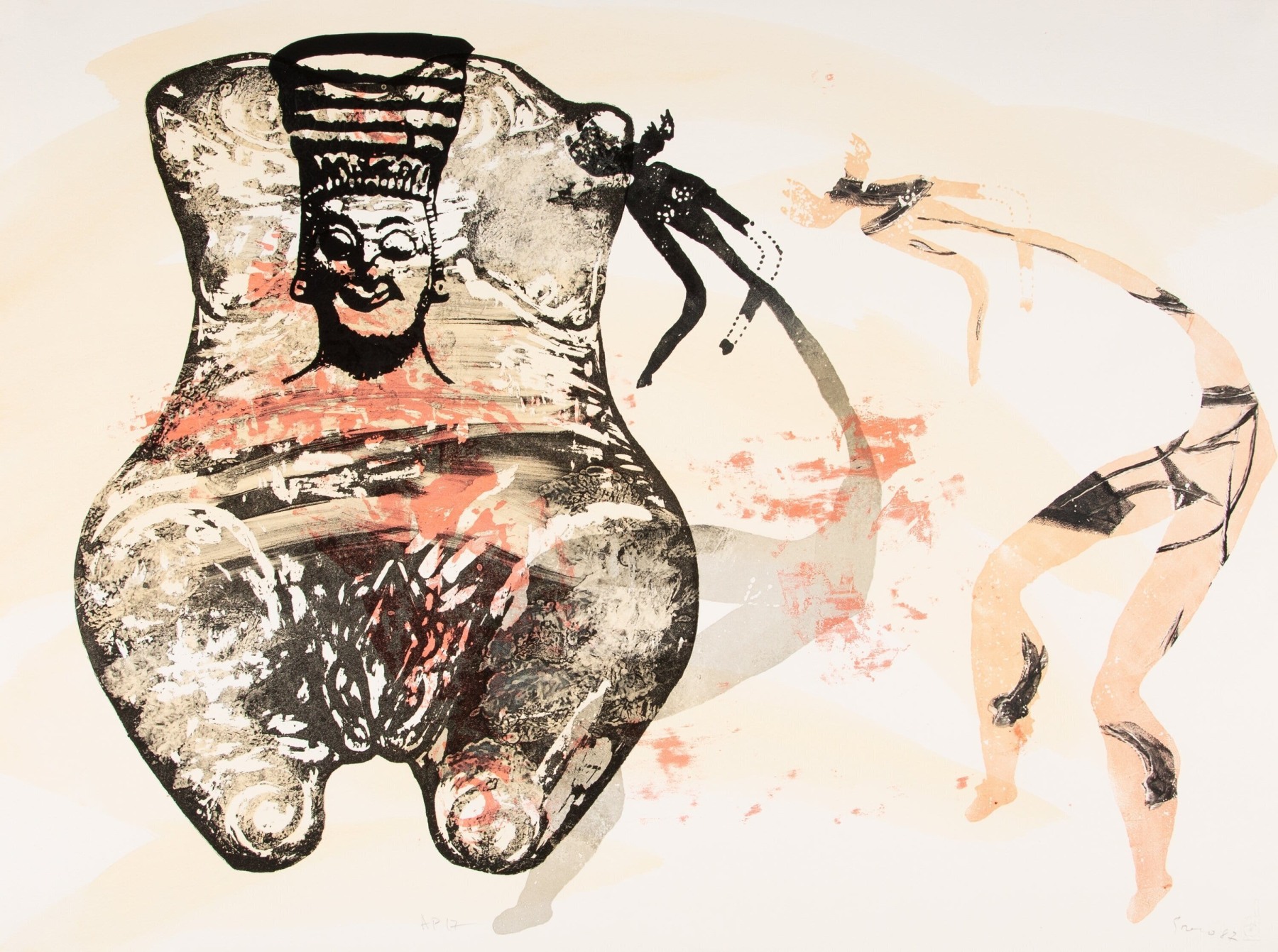
Nancy Spero, Goddess II, 1987. Hand-colored letterpress and lithography, 22 x 30 inches (55.9 x 76.2 cm), Edition 14 of 100 (#14/100).
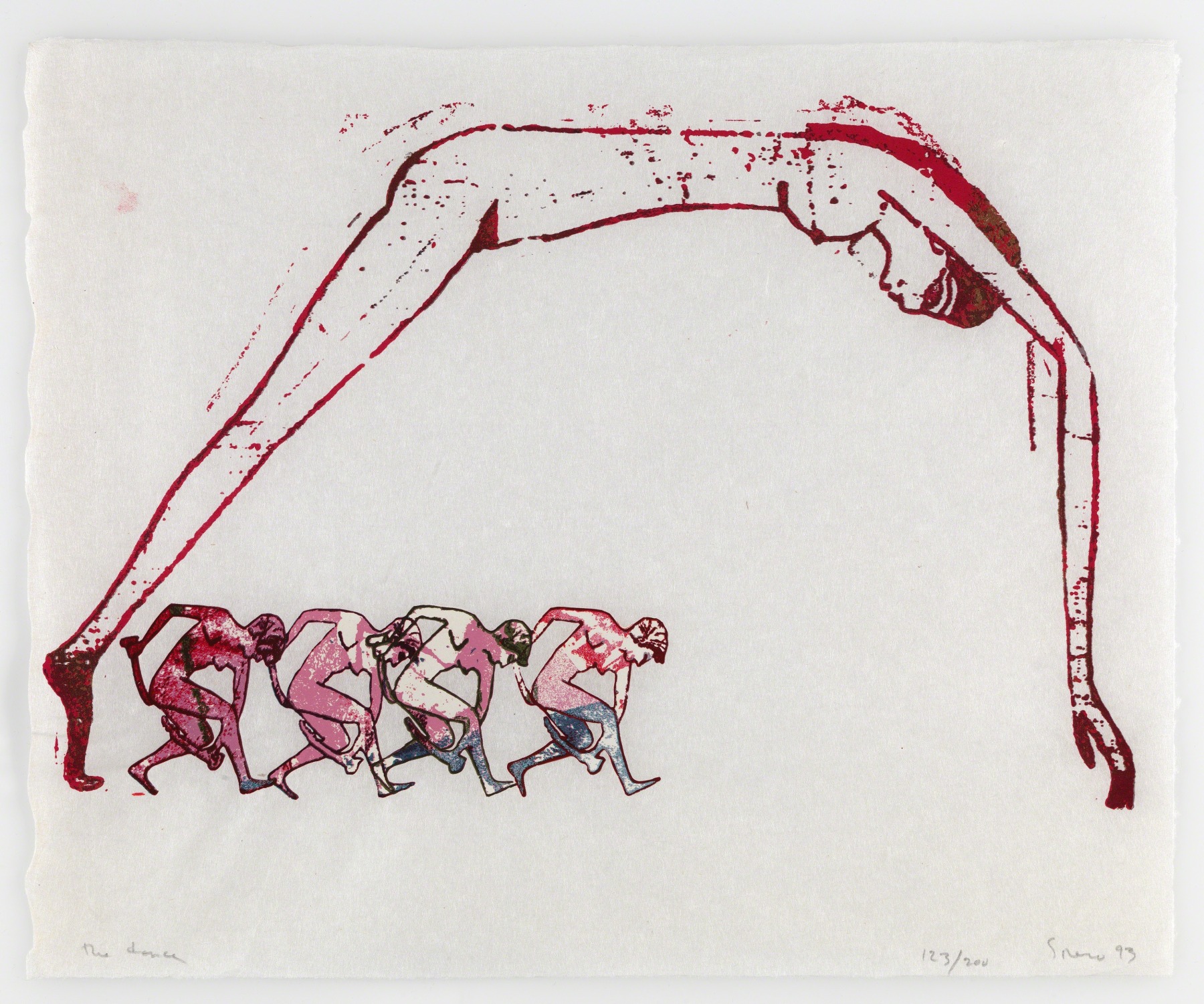
Nancy Spero, The Dance, 1993. Silkscreen, 13 1/2 x 11 inches (34.3 x 27.9 cm), Edition of 50 plus 20 AP.
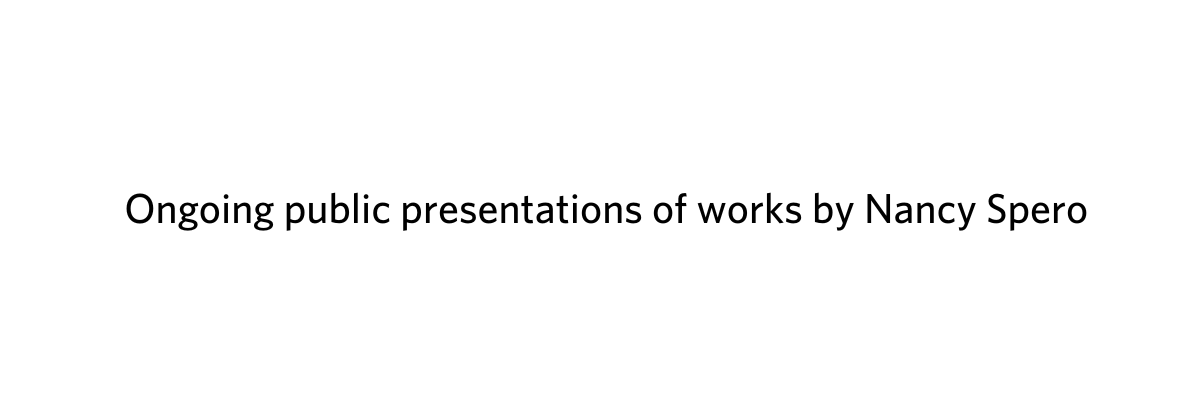
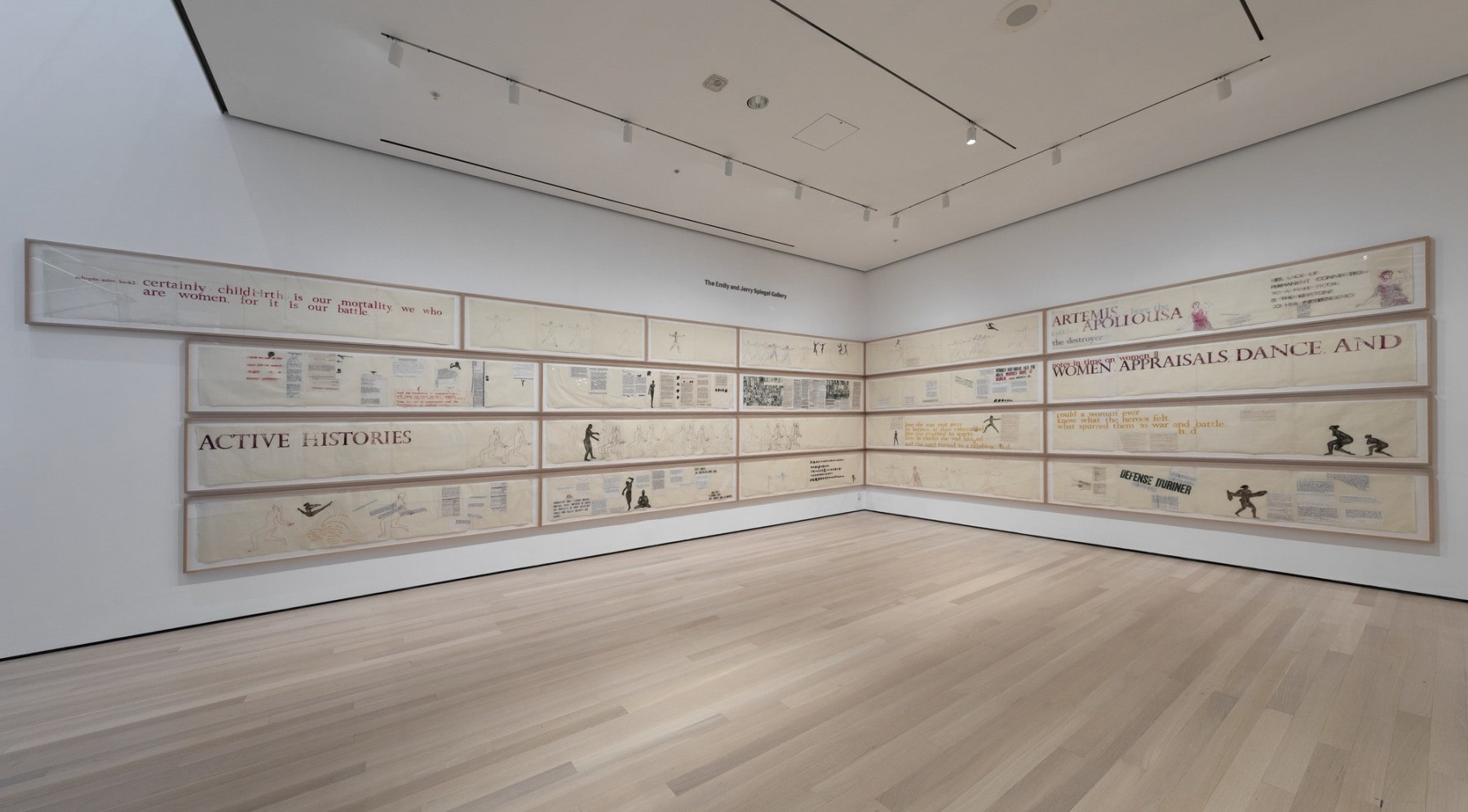
Nancy Spero, Notes in Time, 1979. On view at the Museum of Modern Art, New York City, collection of the museum. Watch Leah Dickerman, director of MoMA’s research programs, take a close look at Nancy Spero’s scroll-like alternate history presented as she wonders how we “understand the mythological structures that support inequity in our culture.”
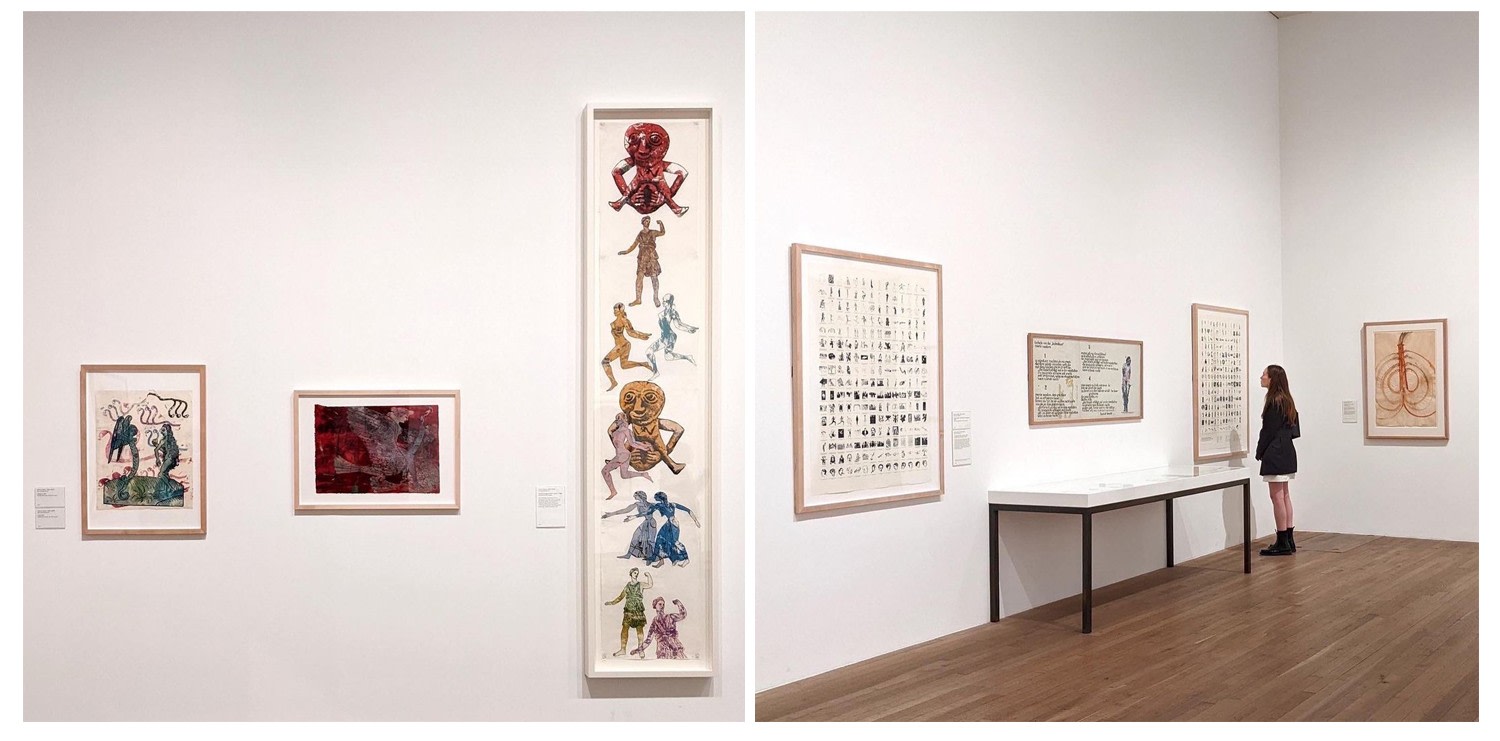
A collection display of work by Leon Golub and Nancy Spero is now open at Tate Modern, London. Photos above courtesy of Frith Street Gallery, London, which will hold the solo exhibition Nancy Spero: Dancers & Goddesses from September 23 to November 5, 2022, organized in collaboration with Galerie Lelong & Co. and the Spero Golub Foundation.
References:
Ault, Julie. “Nancy Spero.” Artforum, February 2010.
Harris, Susan, Nancy Spero, Juan Vicente Aliaga, and Centro Galego de Arte Contemporánea, eds. Nancy Spero: weighing the heart against feather of truth [Centro Galego de Arte Contemporánea. 24 de setembro de 2004 - 6 de xaneiro de 2005]. Santiago de Compostela: Centro Gallego de Arte Contemporáneo, 2004.
McEvilley, Thomas. “Nancy Spero.” Artforum, Summer 1986.
This presentation was organized with curatorial and research support from Elizabeth Desir.